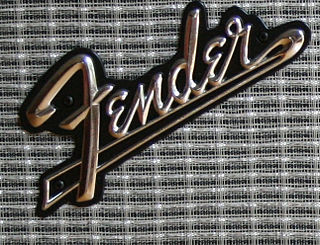
Fender amplifiers are a series of electric instrument amplifiers produced by the Fender Musical Instruments Corporation. The first guitar amplifiers attributed to Leo Fender were manufactured by the K&F Manufacturing Corporation (K&F) between 1945 and 1946. Later, Fender began building its own line of electric guitars. Fender amplifiers would become favorite of many famous guitarists such as Jimi Hendrix, Eric Clapton, and Stevie Ray Vaughan, also known in these cases for playing Fender guitars.
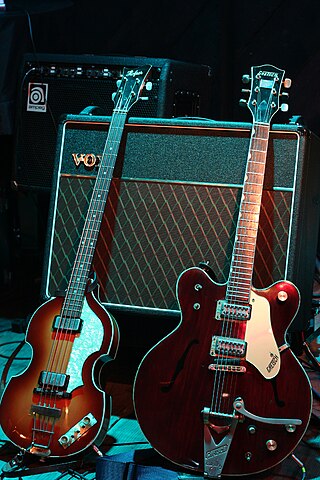
The Vox AC30 is a guitar amplifier manufactured by Vox. It was introduced in 1958 to meet the growing demand for louder amplifiers. Characterised by its "jangly" high-end sound it has become widely recognized by British musicians and others, such as George Harrison and John Lennon of the Beatles, Bill Wyman of the Rolling Stones, Brian May of Queen, Dave Davies of the Kinks and Hank Marvin.

The Fender Twin and Twin Reverb are guitar amplifiers made by Fender Musical Instruments Corporation. The Twin was introduced in 1952, two years before Fender began selling Stratocaster electric guitars. The amps are known for their characteristically clean tone.

The Fender Hot Rod Deluxe is a guitar amplifier manufactured and sold by the Fender Musical Instruments Corporation. It was introduced in 1996 as part of the "Hot Rod" line of guitar amplifiers and has been in continuous production since. The Hot Rod Deluxe is a modified version of the Fender Blues Deluxe from the earlier Blues line of amplifiers, and has a higher level of gain in its preamplification signal. This model, along with the Hot Rod Deville, were originally designated as F.A.T. amplifiers but this moniker was dropped in 2002 when production of this series of amps was moved from Corona, CA to Fender's Baja-Ensenada, Mexico manufacturing facility.
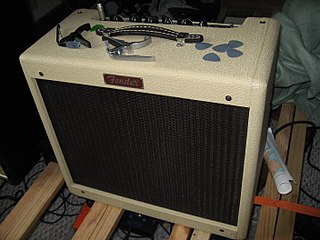
The Blues Junior is a tube guitar amplifier introduced in 1995 by the Fender Musical Instrument Corporation. It is aimed at achieving the warm, tube-driven tone common in many styles of American blues and blues rock dating back to the 1950s, while remaining both portable and affordable. A popular amp, Fender have released numerous versions since its initial release, the most recent being the version IV in 2018. Fender also frequently releases limited editions of the Blues Junior, such as the Lacquered Tweed and the "80 Proof".

The Fender Bassman is a series of bass amplifiers introduced by Fender during 1952. Initially intended to amplify bass guitars, musicians used the 5B6 Bassman to amplify other instruments, including electric guitars, harmonicas, and pedal steel guitars. Besides being a popular and important amplifier in its own right, the Bassman also became the foundation on which Marshall and other companies built their high-gain tube amplifiers.
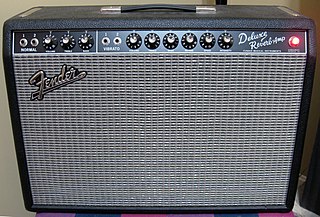
The Fender Deluxe Reverb is a guitar amplifier made by the Fender Electric Instrument Company and its successors. It was first introduced in 1963 by incorporating an onboard spring reverb tank to the newly redesigned Fender Deluxe amplifier.
The Fender Concert was a guitar amplifier made by Fender Musical Instruments. Its production can be split over 2 phases. The first of these running from 1960 and until approximately 1965, at which time a typical Fender Concert was priced at $315. During the 1960s, the Concert was for all practical purposes the same amplifier as the Vibrasonic but with four 10" speakers. In a later phase, the Concert was updated by Paul Rivera in the early 1980s and a subsequent 1x12 variant of the Concert amp appeared briefly in the mid-1990s.
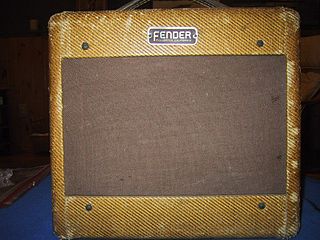
The Fender Champ was a guitar amplifier made by Fender. It was introduced in 1948 and discontinued in 1982. An updated version was introduced in 2006 as part of the "Vintage Modified" line.
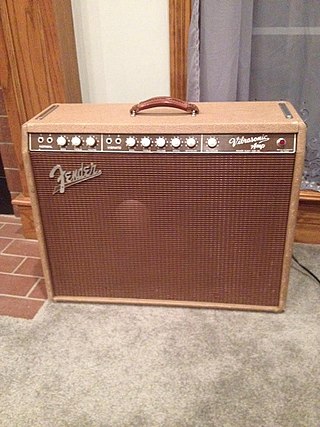
The Fender Vibrasonic was an amplifier made by Fender. It was debuted as the first of the new-model Fender amps of the 1960s, with new tolex-covered cabinets and front-mounted control panels that would replace the tweed-covered, top-panel cabinets that were prevalent during the 1950s, as well as new circuitry which would characterize most Fender amplifiers for two decades.
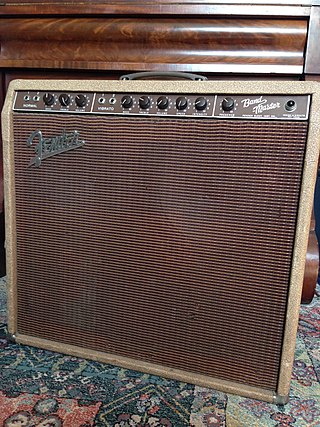
The Fender Bandmaster was a musical instrument amplifier made by Fender. It was introduced in 1953 and discontinued in 1974. Some early models had both a microphone input and instrument inputs. Beginning in 1960, Bandmaster amps were equipped with a vibrato effect. In the 2000s, vintage Bandmaster amps remain in use by blues, Americana and rock and roll bands.
The Fender Bandmaster Reverb was a tube amplifier made by Fender. It was primarily a Silverface Bandmaster piggyback 'head' with the addition of reverb and vibrato and a modified circuit that shared more similarities with other Fender amplifiers. It was introduced in 1968 and was discontinued in 1980 .The Bandmaster Reverb was produced in both a 40 watt and 70 watt tube variant, before being reissued as a vintage modified amplifier.

The Fender Princeton was a guitar amplifier made by Fender. It was introduced in 1946 and discontinued in 1979. After Fender introduced the Champ Amp in 1948, the Princeton occupied the next to the bottom spot in the Fender line. Fender Princetons from the early models into the 1970s models are highly valued particularly as recording amplifiers.

The Fender Super was a guitar amplifier made by Fender between 1947 and 1963 and, as the Super Reverb, until 1981. Though it was designed for a clean sound, its overdriven sound is praised by players and critics.
The Fender Reverb Unit (6G15) was a vacuum tube, spring reverb-equipped effects unit made by Fender. The Reverb Unit was originally introduced in 1961. It was discontinued in 1966 and was replaced by a solid-state model, the FR1000. The unit features three controls: Dwell, Mixer and Tone and includes a 12AT7 tube as a preamplifier; a 6K6 tube as the reverb driver; and a 12AX7 as the reverb recovery tube. The rectifier is a diode-type solid state unit. The circuit board, like Fender's Brownface, Blackface and Silverface amplifiers is an eyelet board and the unit its completely hand wired. The spring reverb “tank” is mounted on the interior side of the front baffle in a vertical position. Tanks were supplied by Gibbs and Accutronics in the original version. The vertically mounted tank should be a 4AB3C1C but most actually shipped with 4AB3C1B tanks which are designed for horizontal mounting; these are the same ones found in the Fender combo amps where it is mounted on the floor in a horizontal configuration. Physically, the unit looks like a small amplifier head and since the early 1960s the unit has become synonymous with surf music.
The Fender Deluxe guitar amplifier is a range of non-reverb guitar amplifiers produced by Fender. The amplifiers were originally produced from early 1948 to 1966 and reissues are in current production. Its predecessor was the Fender Model 26 "Woodie" produced from 1946 to 1948.

The Fender Pro Reverb is a high-end guitar amplifier made by Fender. It was in production from 1965 and was discontinued in 1982. The Pro Reverb is a 40-watt tube amplifier and has a pair of 12-inch (30 cm) speakers; however, models later than 1976 were increased to 70 watts. Teagle and Sprung, authors of the definitive book on Fender amplifiers described the Blackface Pro Reverb as the best amplifier ever produced likely due to its combination of the two twelve inch speakers, its high quality reverb and tremolo, and just the right amount of power to get either classic Blackface Fender cleans or natural tube breakup at reasonable volumes. They wrote, "the author recommends these amps as the best all-around amp ever made—by anyone".
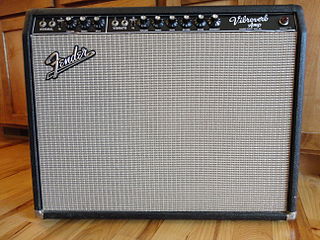
The Fender Vibroverb was a 40-watt combo guitar amplifier originally manufactured in 1963 and 1964. It was the first Fender amplifier to incorporate on-board reverb and tremolo/vibrato, which became a standard feature on many high-end Fender tube amps during the 1960s and 1970s.

The Fender Harvard is a vacuum tube (valve) guitar amplifier made by Fender from 1955 to 1963. The Harvard appeared only in a tweed covered "narrow-panel" cabinet, but in two very different circuit designs, namely 5F10 (1955–61) and 6G10 (1962–63).
The Fender Pro was an instrument amplifier manufactured by Fender Electric Instruments from 1946 to 1965. It was characterized by its dual 6L6-family power tubes and single 15" speaker, with output power increasing from 18 watts up to 40 watts over its production run. The Pro was replaced in the Fender lineup by its offspring the Pro Reverb.














